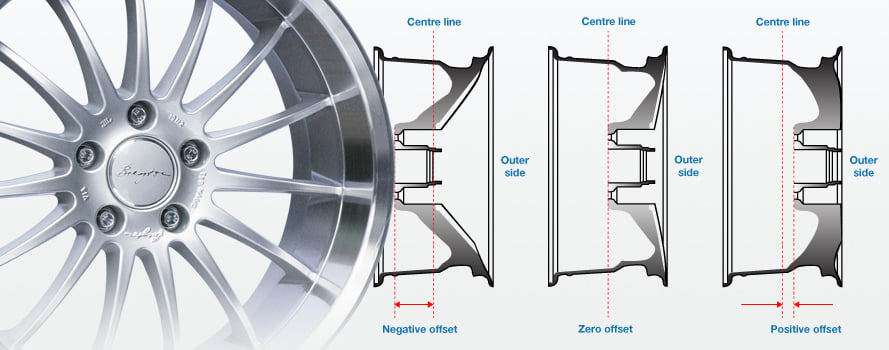
JAX Tyres also offers a range of great value wheels and tyres for your vehicle available online & instore.
Wheels and the Law Measuring Offset and PCD
Each state has certain legal requirements, when wheels outside the manufacturers recommended range are fitted to a vehicle.
These requirements mainly relate to wheel rim widths, the fitting of nuts and studs and the increase of track measurement.
Modifications outside the legal guidelines are not permitted and the correct matching of wheels and tyre is vital to ensure the continued safe operation of the vehicle. See your JAX Tyres wheel specialist for the best advice on all performance and safety aspects.
Wheel Care and Maintenance
For lasting care of your alloy wheels it is recommended you clean them regularly with soap and water. Check first before using automotive detergents, as they may corrode the alloy metal. Re-tension your wheel nuts or studs with a wheel brace on a regular basis.
Insurance
Please make sure that you check with your insurance company to ensure that your choice of wheels is compatible with your car.
Measuring Offset and PCD
There are two ways of measuring offset. Centre line offset is the distance from the centre line of the wheel to the face of the wheel mounting surface. Back space offset is the distance from the extreme back edge of the rim to the wheel mounting surface. Pitch Circle Diameter (PCD) is the diameter of the bolt circle.
Centre Bore
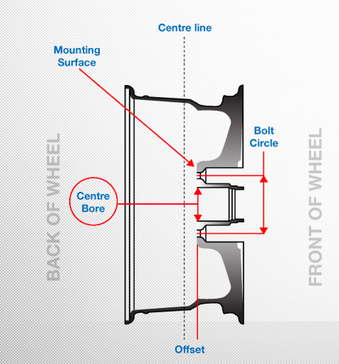 The centre bore is the location hole that is machined in the centre of the wheel. This will vary from one vehicle to another. It is essential to have the correct centre bore for the vehicle to avoid wheel imbalance problems, which will lead to poor ride comfort.
The centre bore is the location hole that is machined in the centre of the wheel. This will vary from one vehicle to another. It is essential to have the correct centre bore for the vehicle to avoid wheel imbalance problems, which will lead to poor ride comfort.
Wheel manufacturers and distributors have universal fittings and are drilled to fit a wide range of vehicles. In order to obtain the correct fitment for a particular vehicle, a correct locating or spigot ring most be inserted into the rear of the wheel.
Wheel P.C.D
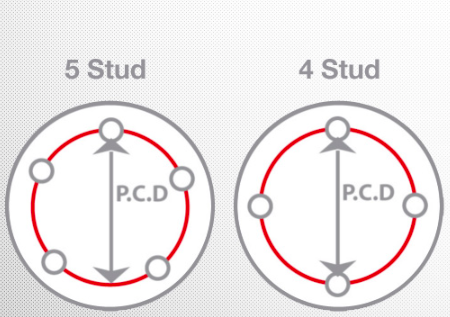
PCD is an abbreviation for pitch circle diameter and is the diameter of the circumference of the centreline of the stud fixing holes on the wheel mounting face.
Wheel Offset
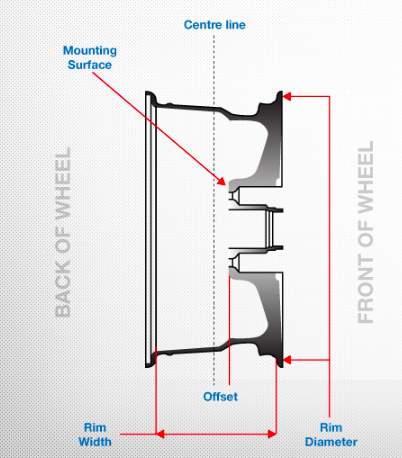
General
The offset of the wheel is a fundamental technical parameter that must be carefully considered when choosing replacement wheels.
The offset of the wheel is defined as the measured distance in mm from the hub mounting face to the centreline of the wheel.
Fitments of Wheels with an Incorrect Offset
Care must be taken to not fit wheels with incorrect offsets, as this could influence negatively the vehicle's handling performance. Other areas that may be affected are wheel bearing loading and bodywork clearance. The best option is always to follow the manufacturer's recommendations.
Wheel Offset Types
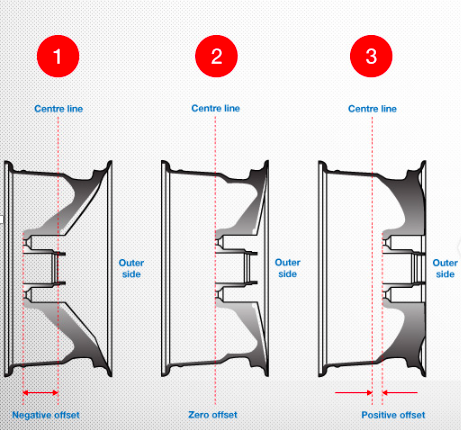
- Negative Offset
This is where the hub mounting surface is positioned towards the internal side of the wheel. This type of offset is used on wheels fitted to rear wheel drive vehicles. If an offset is described as 35N this is an indication that the measurement is 35mm from the tyre's centreline with a negative offset. - Zero Offset
This is where the hub mounting surface is even with the wheel's centre line - Positive Offset
This is where the hub mounting surface is positioned towards the external side of the wheel. This type of offset is used for wheels fitted to front wheel drive vehicles. If an offset is described as 35P this is indication that the measurement POsItive offset is 35mm from the tyre's centreline with a positive offset.
X-Factor
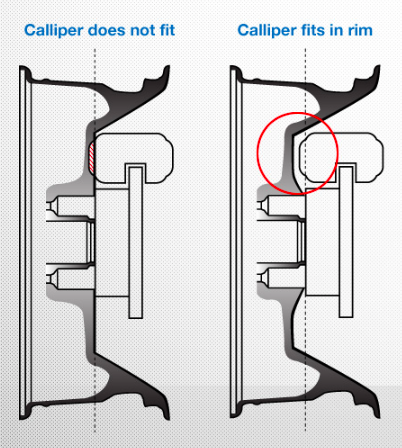
Calliper Clearance (X-factor) is the amount of clearance built into the wheel to allow for the vehicle's disc brake and calliper assembly.
A wheel’s PCD is its Pitch Circle Diameter. It’s also known as its “Bolt Pattern” or “Bolt Circle”. It’s the diameter of an imaginary circle formed by the centre of the lugs, which passes through the centre of all the studs, wheel bolts or wheel rim holes.
For example, 5 X 4.5inch, or 4 X 100mm.
The wheel offset is a measurement of how far the mounting face of your vehicle's wheels is away from the centre line of the wheel. You can have a negative, positive or zero-wheel offset:
- Zero wheel offset: the mounting hub surface is in line with the centreline of the wheel
- Positive wheel offset: The mounting hub surface is in front of the wheel's centreline, towards the "show-side". A positive wheel offset can be found on most front-wheel vehicles and new rear-wheel vehicles.
- Negative wheel offset: the mounting hub surface is behind the centreline of the wheel. Most deep-dish wheels have a negative wheel offset, but it's less common than a positive offset.
We recommend getting your offset measurements checked by a professional as if they’re wrong it can cause major problems to the handling and performance of your vehicle.
A negative offset will push your wheel out, and a positive offset will tuck it under the fender.
A positive offset means your wheel is mounted closer to the outside or roadside, which pushes it further under the guard.
If you had a zero offset and changed your wheel to a +30 offset rim, your wheel will be tucked in by 30mm.
A negative offset is when your wheel is mounted further away from the roadside. As a result, your wheel will push towards or past the guard.
If you changed your offset from zero to a -10 rim, your wheel would be 10mm away from the centreline - meaning your wheel would pop out by 10mm.
Each state has different legal requirements for wheel's fitted outside the manufacturer's recommended range.
Modifications outside the legal guidelines are not permitted, and the correct matching of wheels and tyres is vital to ensure the continued safe operation of the vehicle.
- For most states and territories, including Queensland and Victoria, Western Australia and the Australian Captial Territory, a passenger vehicle's wheel track must not be increased by more than 25mm beyond the maximum specified for your model by the vehicle manufacturer. You may not change the offset by more than 12.5mm per wheel.
- In South Australia, wheel track measurement may not be more or less than 15mm beyond the maximum specified by the vehicle manufacturer.
- In New South Wales, you can't alter your offset past the maximum specified in your vehicle's placard. For off-road and commercial vehicles, fitted with front and rear beam axles, you can increase the wheel track up to 50mm in total, which means your offset limit is 25mm per wheel.
See your JAX Tyres & Auto wheel specialist for the best advice on all performance and safety aspects.
There isn't any offset that is better or worse than another
It depends on what specific result you're trying to achieve. The two primary goals are better stable handling or better stance or wheel fitment.
A negative offset pushes your wheels outwards towards or past the fender. You may want a negative offset for:
- A wider track: A wider track will give you better stability when cornering.
- Better stance: this is a purely cosmetic reason.
- Better traction on 4WD: Widening your track on off-road vehicles allows them to grip better on slushy and uneven terrain.
While offering a wider track and a better stance, you'll reduce the ability to feel when the wheels are about to lose traction on passenger vehicles. It can also cause fender rubber issues and premature wear on the axles, bearings and driveline.
Most car manufacturers usually prefer positive offset tyres. The advantages include:
- Easier to fit wider tyres: If you have an off-road vehicle, having a positive offset means having wider tyres without pushing them out. This works as 4WD's have enough clearance space around the wheel.
- Wheels tucked inside: Some people prefer their vehicles like this for cosmetic reasons.
- Eliminate guard rubber issues
Clearance issues are the major downside of positive offset wheels. As a result, most positive offset wheels are on off-road vehicles with greater clearance around the wheel. If there is not enough clearance, your vehicle will have problems with its sideways movement when turning and vertical direction when going over bumps.
A zero offset is when the mounting hub surface is in line with the centreline of the wheel.

